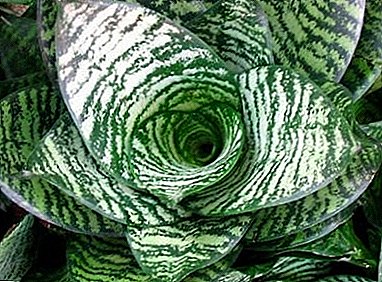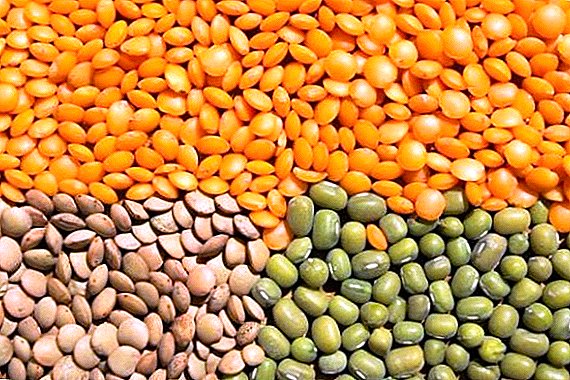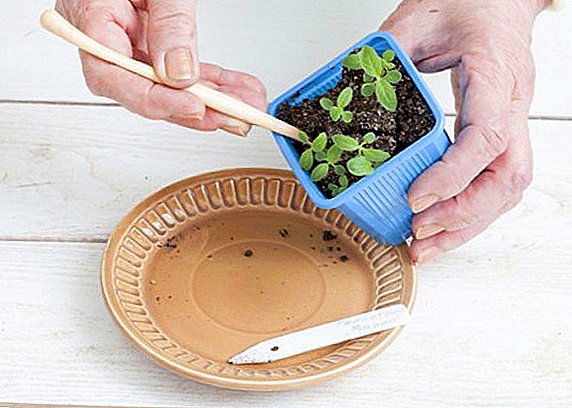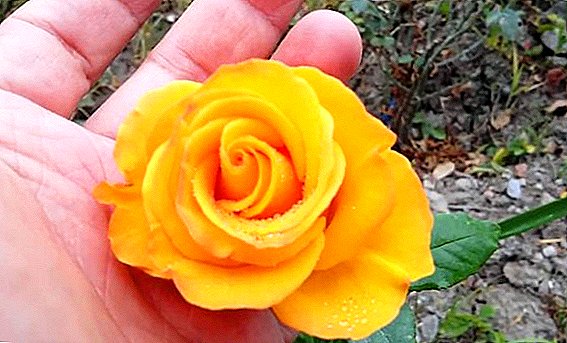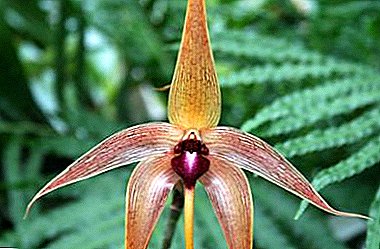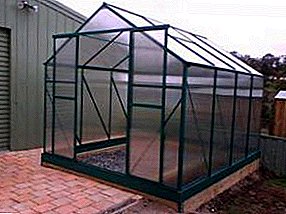 Vika - plant of the legume family, which is also sometimes called sowing peas. It can grow as a wild plant on uncultivated areas, near the edge of the roads, and can be used as a cultivated plant. In the latter case, Vika is more often raised for animal feed. This material focuses on how to grow cultivated plants.
Vika - plant of the legume family, which is also sometimes called sowing peas. It can grow as a wild plant on uncultivated areas, near the edge of the roads, and can be used as a cultivated plant. In the latter case, Vika is more often raised for animal feed. This material focuses on how to grow cultivated plants.
Vic: description and types
 First of all, you should understand what a vetch is, what it looks like and what kinds it happens. Depending on the type of plant can be perennial, and maybe one-year. Stems may be erect, but in some species they creep, which cling to the antennae. It reaches a height of 20-100 cm. Numerous leaves have stipules, with pinnate. Vertices may be jagged or entire. The main forms: wedge-shaped, linear, oblong. Leaf axis crowns strong mustache.
First of all, you should understand what a vetch is, what it looks like and what kinds it happens. Depending on the type of plant can be perennial, and maybe one-year. Stems may be erect, but in some species they creep, which cling to the antennae. It reaches a height of 20-100 cm. Numerous leaves have stipules, with pinnate. Vertices may be jagged or entire. The main forms: wedge-shaped, linear, oblong. Leaf axis crowns strong mustache.
Vika grass blooms with white, yellowish-white, purple or blue flowers. They can be single axillary, and can be collected in bunches of two or three flowers. Corollas have a sail-like shape. Peduncles are identical in length with the leaves or may slightly exceed them. Flowers appear in June and hold until August. After flowering, oblong flat beans appear, which can be double-seeded, multi-seeded, beard-shaped. The rhizome of the plant is branched, pivotal. It develops deep inside and is able to find enough nutrients.
In total, at least 140 species of peas are known that grow in East Africa, South America, and Europe. These are leguminous crops, fodder and ornamental. A species of Vicia faba, which is known as a garden bean, is cultivated in Mexico, Thailand, and China as a legume crop for food use. Vika sowing or common Vicia sativa L has found widespread in our latitudes. It has red-blue stems, round brown beans and oblate dark gray grains. It is a creeping plant that reaches 110 cm in length. On the branches grow feathery paired leaves of 5-8 pairs.
 Winter vetch - another type of plant, distinguished by ripening and drought tolerance. Its nutritional properties are comparable with alfalfa, so it is used for grass meal, hay, haylage, green fodder, early silage. The most common pea in our strip is spring. This vetch is a nutritious plant, therefore it has found its application in agriculture as fodder grass. 123 g of protein per 100 kg of its dry mass. Among ornamental species, Vika Kashubian (Vicia cassubica L., which is common in Scandinavia and Central Europe) is worth mentioning. The perennial has creeping slightly pubescent stems, which extend up to 60 cm in length. have an oval or oblong shape. Dropping red-purple flowers are collected in axillary peduncles of 10-15 pieces. They bloom in mid-summer. The fruits are obtained on one or three oval-shaped seeds, flat. The plant is poorly tolerant, withstands temperatures down to -29 ° C.
Winter vetch - another type of plant, distinguished by ripening and drought tolerance. Its nutritional properties are comparable with alfalfa, so it is used for grass meal, hay, haylage, green fodder, early silage. The most common pea in our strip is spring. This vetch is a nutritious plant, therefore it has found its application in agriculture as fodder grass. 123 g of protein per 100 kg of its dry mass. Among ornamental species, Vika Kashubian (Vicia cassubica L., which is common in Scandinavia and Central Europe) is worth mentioning. The perennial has creeping slightly pubescent stems, which extend up to 60 cm in length. have an oval or oblong shape. Dropping red-purple flowers are collected in axillary peduncles of 10-15 pieces. They bloom in mid-summer. The fruits are obtained on one or three oval-shaped seeds, flat. The plant is poorly tolerant, withstands temperatures down to -29 ° C.
Vicia cracca L., or mouse vetch, grows in the USA and Eurasia. The perennial grows to 180 cm. The paired leaves are kept on short petioles, a branch tendril is formed at the other end. Stipules grow to a centimeter in length. The sheets are approximately 0.6 cm wide and 3 cm long and grow 6–15 pairs in length, linear-lanceolate. Drooping flowers of bright blue or purple are collected in axillary brushes of 1-30 pieces. Corolla grows to 1.3 cm in length. Flowering lasts from June to August. It is considered a good honey plant. Beans grow to 2 cm in length, have a concise, oblong-rhombic shape. The plant is also frost resistant.  Among the ornamental varieties of the plant, it is worth noting Vika Fencing (Vicia sepium L.), the description of which is similar to the previous varieties. The only thing that leaves grow 3-9 pairs, and dull-purple flowers are collected in brushes of 2-6 pieces. Flowering lasts from June to October. In the gardens, they also grow a perennial Vika single-pair (Vicia unijuga A. Braun). Her erect numerous stems are stretched to 70 cm in height. Parotid leaves have only one pair. Bright blue or purple flowers up to 1.5 cm in length are collected in multi-flower brushes. Flowering lasts from June to August. The fruits are bare, flat. The plant can withstand temperatures down to -18 ° C.
Among the ornamental varieties of the plant, it is worth noting Vika Fencing (Vicia sepium L.), the description of which is similar to the previous varieties. The only thing that leaves grow 3-9 pairs, and dull-purple flowers are collected in brushes of 2-6 pieces. Flowering lasts from June to October. In the gardens, they also grow a perennial Vika single-pair (Vicia unijuga A. Braun). Her erect numerous stems are stretched to 70 cm in height. Parotid leaves have only one pair. Bright blue or purple flowers up to 1.5 cm in length are collected in multi-flower brushes. Flowering lasts from June to August. The fruits are bare, flat. The plant can withstand temperatures down to -18 ° C.
How to sow Vika
Although vetch vetch have many varieties, care for them is about the same. But planting dates vary depending on the type of plant.
Landing dates
As a general rule, if the plant is sown on grain or for feed, plant it in late April or early May. Do this together with other plants to drown out the growth of weeds. For the autumn feed it is sown on a plowed field after harvesting rye in July. Vika is planted for winter in late August; then in spring she will rise and grow before planting tomatoes and peppers.
Important! It is recommended to sow the plant with other plants: corn, sunflower, wheat, oats, barley. It also reduces the content of vicinin and vicin alkaloids in the plant, which give it a bitter taste.
Grass planting scheme
The plant propagates with seeds, which are sown to a depth of about 2 cm. The row spacing should be a little less than 10 cm. However, due to the arbitrary planting the plant will not become worse. It grows well in combination with cruciferous. In this case, they are recommended to land in a checkerboard pattern. On a weave of land, about 2 kg of seeds should be sown.
Important! The plant is not recommended to be sown in fresh manure, otherwise it can support. This dramatically reduces its feed quality.
The first shoots should appear a couple of weeks after sowing, and from the fifth day sprouts begin to branch. The first flowers appear in a month and keep a maximum of a month. At the end of flowering about four weeks later the seeds ripen. Depending on the variety, the growing season lasts from 70 to 120 days.
How to care for Vika
 Vika requires not only a special landing, but also care. As soon as the first sprouts appear, the plant is recommended to feed. The next feeding should take place during the formation of buds. At this stage, Vika is recommended to prune and hide in the soil. This is usually done by a cultivator. The event must be accompanied by a regular feeding. Trimming is done once or twice per season. This helps the plant to develop better and fill with juices.
Vika requires not only a special landing, but also care. As soon as the first sprouts appear, the plant is recommended to feed. The next feeding should take place during the formation of buds. At this stage, Vika is recommended to prune and hide in the soil. This is usually done by a cultivator. The event must be accompanied by a regular feeding. Trimming is done once or twice per season. This helps the plant to develop better and fill with juices.
Initially, the plant should be watered as needed, but as soon as the period of bud formation begins, watering should be increased. However, this should also be done with caution, since the vetch also grows reluctantly on the overwetted soil.
The plant has no special requirements for the soil, it can be infertile, but preferably light. Best of all, Vika feels rich in calcium. The plant is of little interest to pests and is not subject to serious diseases. Sometimes during dry periods it can be attacked by aphid.
Cleaning wiki for hay
If the plant is planted on food, then the ideal time for mowing will be the period of fruit formation. At this time, ash elements, proteins and other useful substances are concentrated in stalks and leaves.
Did you know? Before mowing, check whether the plant has not ripened or fallen. In this case, the cattle eat it reluctantly. Moreover, such hay is bad for cattle milk, and for cows it can cause miscarriage.
How to get wiki seeds
 When about 70-80% of the fruits of the wiki become brown, it is time to collect the seeds. Up to 10 centners of plant seeds can be removed per hectare of land. If you skip this phase and collect the seeds later, this figure can be significantly reduced. Over-grown fruit capsules crack easily, especially in sunny weather, which causes seeds to fall to the ground. If you collect the fruits earlier, you will receive planting material of different degrees of maturity.
When about 70-80% of the fruits of the wiki become brown, it is time to collect the seeds. Up to 10 centners of plant seeds can be removed per hectare of land. If you skip this phase and collect the seeds later, this figure can be significantly reduced. Over-grown fruit capsules crack easily, especially in sunny weather, which causes seeds to fall to the ground. If you collect the fruits earlier, you will receive planting material of different degrees of maturity.
It is divided into the following degrees:
- dairy - fruits are green;
- milky-wax - green-brown;
- wax - brown and hard;
- full - brown with a waxy bloom, hard.
Immature seeds can also germinate, but their quality suffers greatly. They have an insufficient concentration of beneficial substances, therefore germination of the embryo is not always successful. After collecting the seeds, they must be dried and ripened. To do this, they are laid out in a dry warm place, protected from the rays of the sun. If the period of post-harvest ripening will last 1-3 months, you can achieve the highest seed germination rates.
Useful properties of wiki (for soil)
 The main beneficial property of the plant is that it accumulates nitrogen in the soil. This plant is grateful to the huge amount of tuberous bacteria that live on its rhizome. That is why Vika is an ideal neighbor for plants that need an increased nitrogen content in the soil.
The main beneficial property of the plant is that it accumulates nitrogen in the soil. This plant is grateful to the huge amount of tuberous bacteria that live on its rhizome. That is why Vika is an ideal neighbor for plants that need an increased nitrogen content in the soil.
Did you know? Often the plant is grown for fertilizer. For this spring plant variety is mixed with mustard.
Among other useful properties worth noting:
- excellent soil loosening due to a branched and deep root system;
- protects the soil;
- improves its microflora;
- drowns out the weeds;
- being an excellent honey plant, it attracts a lot of insects that are well pollinated and neighboring plants.
As you can see, Vika is an excellent unpretentious and multifunctional plant. It is useful for clearing the area from weeds, growing feed for livestock, and besides, it has a high decorative value. In the care of peas undemanding. It must be sufficiently watered, but not filled, several times fed, trimmed and removed from the site in time.


